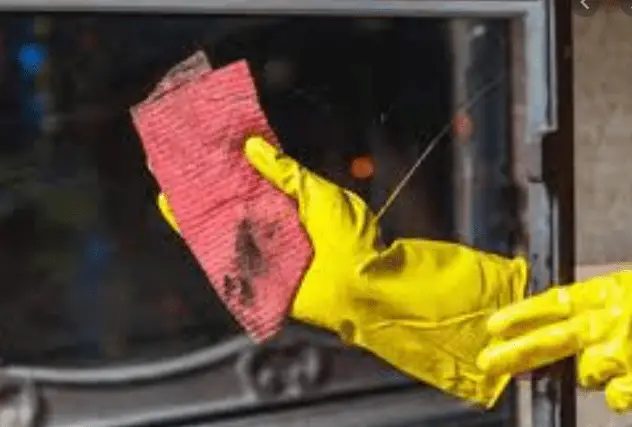Before you get started cleaning the inside and exterior of your wood burning stove, know that this can be a dangerous task. Make sure you understand the risks involved. We have covered off on some basic safety precautions at the end of this article.
- How to clean the outside of an enamel wood stove
- How to clean the outside of a cast iron wood stove
- How to clean and polish an old cast iron type wood burning stove
- How to clean the inside of a wood stove
- How to dispose of wood ash
- Why you should recycle wood stove ash in the vegetable garden
- How to clean a wood stove glass window
- FAQ
How to clean the outside of an enamel wood stove
Depending on what the stove has ben used for will determine the cleaning method. One thing in common is to make sure the stove is cool to the touch before starting.
If the stove is used only for heating and does not have burnt cooking grease then a slightly damp cloth is likely all you will need to wipe off any settled dust.
If there is grease build up then that will have to be broken down with a reactive agent. See the video that uses eucalyptus based hand cleaner, and a little bit of elbow grease.
How to clean the outside of a cast iron wood stove
If the cast iron wood stove contains rust, the rust will need to be removed first.
Removing rust from cast iron requires heavy scrubbing, usually with either steel wool for light stains, or for heavier rust a wire brush or wire wheel mounted in a drill or grinder.
Once all the rust is removed, vacuum debris, brush and then wipe down well with a dry cloth.
How to clean and polish an old cast iron type wood burning stove
There are many types of stove polish on the market. Read the directions and safety precautions for each carefully, this part of the article will advise a generic process for polishing your stove. Just make sure this is for cast iron stoves, not enamel or painted stoves.
Precautions, use on a cold stove only, use gloves, safety glasses, and face mask. Apply in a well ventilated area, and ventilate the room with a fan to circulate the air and remove odor.
Ensure the stove is cold before attempting to apply and type of stove polish.
Using a lint free cloth, apply a thin even coat with the cloth onto a cold surface. Let dry 5 to 10 minutes. Buff to a desired shine with a clean cloth.
Light a fire to burn in or cure the stove. Best done at end of the season when its not too cold to ventillate, as the fumes may become quite strong.
How to clean the inside of a wood stove
- Close the dampers, this will stop air flow from the flue or air inlet from disturbing the fine dust.
- Ideally wait until the coals are completely cold. Stir any coals and make sure nothing is red, you should not be able to feel any warmth emitted when placing you hand close to the coals.
- Shovel out the ashes, and put the ashes into a non-flammable cast iron, metal, or earthenware container, with a secure lid. Shovel as much ash as possible out of the stove before moving onto the next step. Professional tip: if you think there is any chance that ash may be spilt on the floor then place a protective drop sheet down first.
- You can use a paint scraper to get into the corners. Professional tip: try not to use a brush as the bristles can easily flick the fine ash into the air
- If you lucky enough your wood stoves may have a catch box. If so move and jiggle the dampers to loosen the ashes to encourage them to fall into the catch box
- Once most of the ash has been shoveled out, use a vacuum, preferably with a metal attachment on the end of the hose to get the rest of the ash. Ensure the vacuum has fine filters that will trap the ash, not all vacuums will have filters that are fine enough so test a small amount before jumping right in.
- Before packing away the vacuum give the door gasket a once over with the vacuum cleaner.
- There’s a few options to cleaning the glass window, you can use a dedicated stove glass cleaner, with a scrunched up newspaper or steel wool or try our more detailed and cost effective method below.
How to dispose of wood ash
- Add a small amount of water to the ash and stir in, before moving the container. This will turn the ash into a slurry, reducing the risk of airborne ash, and cool off any warm ash you may have missed.
- Carry the ash outside, ensure the lid of your container is secured.
- Mix the ash evenly and thinly into garden soil. Make sure the ash is not just poured on top of the soil it must be dug in to stop it blowing away when it dries out.
- You can either dig small shallow trenches between rows of plants and backfill. Or spread on top of the soil and mix in while added a little more top soil over the top.
Professional tip: If you are a very keen gardener you might like to check your pH levels, ash will tend to neutralize acidic soils.
And check out this video for lots of great ideas for used wood ash.
Why you should recycle wood stove ash in the vegetable garden
Many people say recycling burn wood ash by mixing into the garden provides great results because of the high macro and micro nutrient content, which can have similar effect as common fertilizer. Nutrient content will be a reflection of the firewood that was burnt, but will usually include beneficial amounts of phosphorous, calcium and boron.
Lastly, make sure this is wood ash and not coal ash. Coal ash cannot be disposed of in garden beds as it contains many toxic elements.
How to clean a wood stove glass window
Learning how to keep wood burner glass windows clean is as simple as reducing the smoke inside the fire box by keeping the fire burning as hot as possible, and letting the inbuilt air wash do its thing. Of course, that isn’t how we always want to operate the stove, most times we want to use the slow combustion feature to get the most efficiency. A slow combustion means low air flow, which can mean smoke stays in the fire box longer, depositing stains on the window
glass.
Luckily there is usually an easy way to clean the window glass. Ideally you should clean the window glass as regularly as possible to prevent difficult stains.
The simple trick is to use a slightly damp cloth dipped in the wood ash, this acts as a mild abrasive and will dislodge the soot from the glass with relative ease. You will probably need to rinse the cloth out a few times and reapply ash as you go.
Once the glass is clean, take a clean damp cloth and wipe off the remaining smudge. Lastly for a crystal clean and streak free window use yet another clean cloth, and lightly spray a 2 parts water to 1 part vinegar mix and wipe dry. The vinegar helps to stop water staining and give a streak free result. Really good tip for a major end of season clean.
Caution: Make sure the vinegar and water solution does not come into contact with the cast iron. The cast iron will rust easily if it come into contact with water.


